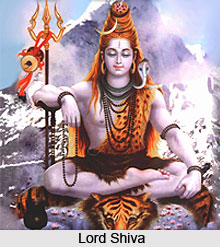 The sacred Mantra to Lord Shiva has also been discussed in the Agni Purana. The Mantra is known as the Prasada (Hroum) and it admits of a division into eight different classes, such as the Sakala (with the phases of beatitude), Niskala (without the phase of beatitude), Shunyam (the Mantra of absolute vacuum), Svamalankritam (adorned by his self), Kshapanam (Mantra of emanation), Kshayani (the Mantra of dissolution), and Kantoshtam. It has been said that the letters of the alphabet required in writing the term Sadashiva should be deemed as the fountain source from which all sorts of success regarding penances, and austerities emanates.
The sacred Mantra to Lord Shiva has also been discussed in the Agni Purana. The Mantra is known as the Prasada (Hroum) and it admits of a division into eight different classes, such as the Sakala (with the phases of beatitude), Niskala (without the phase of beatitude), Shunyam (the Mantra of absolute vacuum), Svamalankritam (adorned by his self), Kshapanam (Mantra of emanation), Kshayani (the Mantra of dissolution), and Kantoshtam. It has been said that the letters of the alphabet required in writing the term Sadashiva should be deemed as the fountain source from which all sorts of success regarding penances, and austerities emanates.
Agni Purana says that the rite of Nyasa in connection, with the Mantra, should be performed by imagining the effulgent images of all the fetters of the alphabet from A to Ksha, as located in the different parts of the body, together with the images of the following manifestations of Lord Shiva, who are their respective tutelary divinities. The gods that preside over each of the fetters are, Kamadeva, Shikhandi, Lord Ganesha, Kala, Shankara, Ekanetra, Dvinetra, Trishikha, Dirgha-Vahuka, Ekapada, Ardha-Chandra, Valapa, Yoginipriya, Shakitishvara, Maha-granthi, Tarpaka, Sthanu,. Dauntura, Nidhisha, Nandi, Padma, Shakunipriya, Mukhavimva, Bheeshana, Kritanta, Prana, Tejashyi, Shakra, Udadhi, Shrikantha, Sinha, Shashanka, Vishvarupa, Ksha, and Narasinha. The next step involves performing the rite of Pancha-Marti Nyasa.
Then the rite of Karanganyasa should be performed by appending the terms of obeisance, such as Namas, Svaha Vasht, Hum, Fut, and Voushat to each of the proper Mantras, enjoined to be repeated on those occasions, together with the names of the different manifestations of the god, such as Sadyojata, Ishvara, etc, who are the regents of those parts of the human body. It has been said that the rite of subsequent Nyasa, should be performed with the component letters of the Shiva Mantra.
After this the Vija-Mantras, known as the Shikhas, coupled with the phonetic symbol of the crescent, and fallowed by the term of obeisance, Fut, should be looked upon as no less than the mighty trident (Pashupata) of Shiva, and as the scourge of all evil-doers.
Nishakala is another part of the Shiva Mantra. It has been said that the Nishkala, or the Panchanga Mantras, sacred to Shiva, consist of the Vijas known as the Oushadha, Vishvarupa, Rudra, Surya, and the half-moon, coupled with the Nada Mantra, Om. A man, by repeating these Mantras, becomes entitled to all the pleasures of this life, and to salvation in the next.
The Mantras which are known as the Shunyas, consist of the Vijas, known as the Anshumana, preceded and followed by the one of the Vishvarupa class, and divested of those which are grouped under the category of the Bramhangas. The Mantra should be made use of by boys and dull persons in general, whereby all impediments to their acquisition of knowledge, would be removed.
The Mantra known as the Kaladhya, consists of the Vijas known as the Anshumana, coupled with the Vishvarupam placed over the one known as the Uhaka. All the essential rites of worship should be conducted in the same way, as laid down in worship with the Sakala Mantras.
It has been mentioned in the Agni Purana that the Mantras known as the Swamalankritam, should consist of the Vijas known as the Narasinha, coupled with the Kritanta, and followed by the Anshuman, coupled with the one of Uhaka class. The rite of Nyasa in connection with the Mantra should be performed with the Mantra, composed of the half moon, the Pranava, the Braroha, the Vishnu, the Udadbi, and the Narasinha Vijas.
Then the Oja Vijas should be first coupled with those known as the Anshumats, and which should be followed by the Anshumats coupled in their turn with the Anshus. The third Vija, should consist of those known as the Anshumana and the Ishvara, and the Mantra, thus framed, should be deemed as the grantor of salvation to its votary. The next Mantra should be composed in the following order:-First the Vija known as the Uhaka, should be written, coupled with an Anshu, which should be followed in due succession by a Varuna, Prana, Tejasha and a Kritanta Vija. The seventh Varna, should consist of the Anshumana, the Uhaka, the Prana, the Padma, the Indu, and the Nandisha Vijas, followed by the one of Ekapadadarik.
Similarly the Mantras, known as the Kshapana, should consist of these ten Vijas, from the beginning. The third, fifth and the seventh feet of the Mantra, should respectively consist of Mantras, numbering half as much. The ninth foot, should consist of the Vija, held sacred to the Sadyojata manifestation of the god, while the second foot, and should consist of the Hrid-Mantras. The Mantras, consisting of the above said ten Vijas, should end with the Fut, and which should be considered as the Astra-Mantra in the present case.
The rites of the Anganyasa in connection with the preceding Mantra should be performed by appending the term Namas to the names of the eight Vidyeshvaras, such as Arianta, Isha, Sukshma, Shivottama, Ekamurti, Ekarupa, Shrikantha and Shikhandi. The images of the manifestations of the god counted from that of Shikhandi to that of Ananta, should be considered as the images of the regents of the Maatra.



















